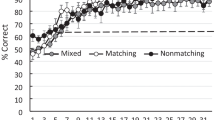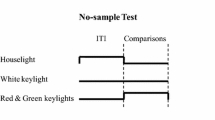Abstract
In Experiment 1, three groups of pigeons were trained in delayed matching-to-sample procedures to investigate the effects of successive responses to a pair of sample or comparison stimuli as compared to responses to a single key. The group that was required to respond sequentially both to the sample and comparison stimuli (Group SEQ-SEQ) was the slowest to reach the criterion. Group SEQ-SG, which was required to respond sequentially only to the samples reached criterion faster and performed better when much longer delay intervals were introduced. In Experiment 2, Group SEQ-SG was further analyzed to determine which contributed to its performance, the sequentiality or the number of responses to the sample. The results showed that the latter was more effective, consistent with prior reports that accuracy on delayed matching-to-sample increases as the number of responses to the sample increases.
Similar content being viewed by others
References
D’AMATO, M. R., & COLOMBO, M. (1988). Representation of serial order in monkeys (Cebus apella). Journal of the Experimental Psychology: Animal Behavior Processes, 14, 131–139.
ECKERMAN, D. A., LANSON, R. N., & CUMMING, W. W. (1968). Acquisition and maintenance of matching without a required observing response. Journal of the Experimental Analysis of Behavior, 11, 435–441.
GRAYSON, R. J., & WASSERMAN, E. A. (1979). Conditioning of two-response patterns of key pecking in pigeons. Journal of the Experimental Analysis of Behavior, 31, 23–29.
GUTHRIE, E. R. (1952). The psychology of learning. New York: Harper & Row.
HOGAN, D. E., ZENTALL, T. R., & PACE, G. (1983). Control of pigeons’ matching-to-sample performance by differential sample response requirements. American Journal of Psychology, 96, 37–49.
HONIG, W. K., & WASSERMAN, E. A. (1981). Performance of pigeons on delayed simple and conditional discriminations under equivalent training procedures. Learning and Motivation, 12, 149–170.
HULL, C. L. (1943). Principles of behavior. New York: Appleton-Century-Crofts.
LASHLEY, K. S. (1951). The problem of serial order in behavior. In L. A. Feffries (Ed.), Cerebral mechanisms in behavior. New York: Wiley.
LOGAN, F. A. (1960). Incentive. New Haven, CT: Yale University Press.
LYDERSON, T., & PERKINS, D. (1974). Effects of response produced stimuli upon conditional discrimination performance. Journal of the Experimental Analysis of Behavior, 21, 307–314.
LYDERSON, T., & PERKINS, D., & CHAIREZ, H. (1977). Effects of fixed-ratio sample and choice response requirements upon oddity matching. Journal of the Experimental Analysis of Behavior, 25, 97–101.
RICHARDSON, W. K., & BITTNER, B. J. (1982). Stimulus stringing by pigeons: Effect of feedback for correct selections. Animal Learning & Behavior, 10, 35–38.
RICHARDSON, W. K., & KRESCH, J. A. (1983). Stimulus stringing by pigeons: Conditional strings. Animal Learning & Behavior, 11, 19–26.
SANTI, A., & ROBERTS, W. A. (1985). Reinforcement expectancy and trial spacing effects in delayed matching-to-sample by pigeons. Animal Learning & Behavior, 13, 274–284.
SKINNER, B. F. (1938). The behavior of organisms. New York: Appleton-Century-Crofts.
SPENCE, K. W. (1950). Cognitive vs. stimulus-response theories of learning. Psychological Review, 57, 159–72.
STRAUB, R. O., BEVER, T. G., & TERRACE, H. S. (1979). Serial learning in the pigeon. Journal of the Experimental Analysis of Behavior, 32, 127–148.
STRAUB, R. O., & TERRACE, H. S. (1981). Generalization of serial learning in the pigeon. Animal Learning & Behavior, 9, 454–468.
TERRACE, H. S. (1983). Simultaneous chaining: The problem it poses for traditional chaining theory. In M. L. Commons, A. R. Wagner, & R. J. Herrnstein (Eds.), Quantitative analyses of behavior: Discrimination processes (Vol. 4, pp. 115–137). Cambridge, MA: Ballinger.
URCUIOLL, P. J., & HONIG, W. K. (1980). Control of choice in conditional discriminations by sample-specific behaviors. Journal of Experimental Psychology: Animal Behavior Processes, 7, 70–86.
WILKIE, D. M., & SPETCH, M. L. (1978). The effect of sample and comparison ratio schedules on delayed matching to sample in pigeon. Animal Learning & Behavior, 6, 273–278.
ZENTALL, T. R., HOGAN, D. E., & EDWARDS, C. A. (1984). Cognitive factors in conditional learning in pigeons. In H. L. Roitblat, T. G. Bever, & H. S. Terrace (Eds.), Animal cognition (pp. 389–405). Hillsdale, NJ: Erlbaum.
Author information
Authors and Affiliations
Corresponding author
Additional information
This article is based upon the first author’s fulfillment of Master’s thesis of Keio University. Portions of the data were presented at the 58th annual meeting of the Japanese Society for Animal Psychology, Nagoya, May 1998. We are very grateful to Izumi Furuya and Shigeru Watanabe for technical supports and many suggestions about this research.
Rights and permissions
About this article
Cite this article
Yamazaki, Y., Sato, M. Effects of Sequential Respondings on Spatial Delayed Matching-To-Sample in Pigeons (Columba livia). Psychol Rec 51, 271–285 (2001). https://doi.org/10.1007/BF03395399
Published:
Issue Date:
DOI: https://doi.org/10.1007/BF03395399




